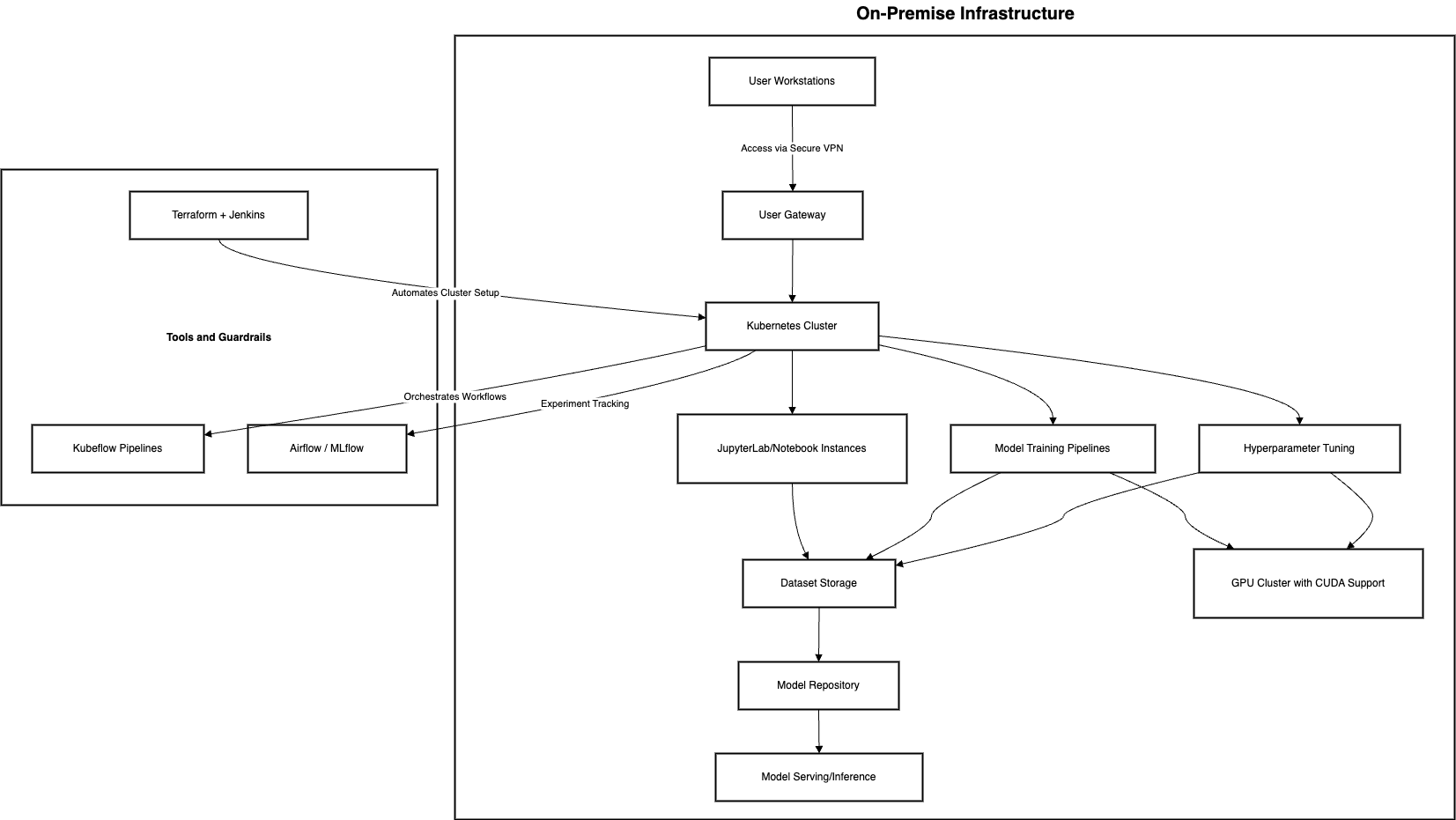On-Premise MLOps Platform
This document outlines the architecture and components of an on-premise MLOps platform for a cell detection system. The platform is designed to enable multiple users to train, tune, and deploy machine learning (ML) models securely and efficiently using a shared dataset. The architecture supports secure isolation for users, incorporates guardrails for compliance and right resource usage, and leverages state-of-the-art tools and technologies to ensure scalability and performance.
High-Level Requirements
- User Isolation: Each user operates in an isolated environment.
- Dataset Sharing: A central repository for a shared dataset of 1000-2000 human cell images.
- Scalability: Horizontally scalable infrastructure to accommodate up to 8-10 users per system.
- GPU Support: CUDA-enabled GPUs for efficient training and hyperparameter tuning.
- Security: VPN access, role-based access controls (RBAC), and data encryption.
- MLOps Features:
- Experiment tracking
- Model management and repository
- Automated hyperparameter tuning
- Workflow orchestration
- On-Premise Deployment: Ensures compliance with local data privacy and security requirements.
Architecture Diagram
The architecture consists of the following layers:
- User Interface Layer
- Compute and Orchestration Layer
- Data Management Layer
- Model Deployment and Serving Layer

https://drive.google.com/file/d/1k1ZNZ_1UO-cFdyQ9IVlCPhFpYzJDL3gF/view?usp=drive_link
Components Overview
- User Workstations: Access via secure VPN.
- Kubernetes Cluster: Manages isolated namespaces and workloads.
- JupyterLab/Notebooks: Interactive environments for experimentation.
- Kubeflow Pipelines: Orchestrates workflows.
- MLflow: Tracks experiments and manages models.
- GPU Cluster: Enables high-performance training.
- Dataset Storage: Centralized repository for images.
- Model Repository: Stores trained models for deployment.
- Terraform + Jenkins: Automates infrastructure setup.
Component Details
1. User Workstations
- Purpose: Provide data scientists with secure access to the platform.
- Key Features:
- Access via secure VPN.
- Interface with JupyterLab for experimentation.
- RBAC ensures controlled access.
2. Kubernetes Cluster
- Purpose: Core orchestration layer for resource allocation and isolation.
- Technologies:
- Kubernetes for container orchestration.
- Namespace isolation for user environments.
- Key Features:
- Auto-scaling to handle increased workloads.
- Secure communication within the cluster.
3. JupyterLab/Notebooks
- Purpose: Provide an interactive workspace for data scientists.
- Technologies: Dockerized JupyterLab instances.
- Key Features:
- Pre-installed libraries (TensorFlow, Keras, etc.).
- Isolated environments for each user.
4. Dataset Storage
- Purpose: Centralized storage for shared datasets.
- Technologies: Network-attached storage (NAS) with encryption.
- Key Features:
- Access control for user security.
- High availability and redundancy.
5. GPU Cluster
- Purpose: Accelerate model training and hyperparameter tuning.
- Technologies: CUDA-enabled GPUs.
- Key Features:
- Resource allocation based on user workloads.
- Integrated with Kubernetes for scaling.
6. Kubeflow Pipelines
- Purpose: Orchestrate ML workflows.
- Key Features:
- Automates data preprocessing, training, and evaluation.
- Logs and monitors pipeline runs.
7. MLflow
- Purpose: Manage experiments, track metrics, and store models.
- Key Features:
- Experiment tracking with metrics visualization.
- Model versioning for reproducibility.
8. Model Repository
- Purpose: Store and manage trained models.
- Technologies: S3-compatible object storage or MinIO.
- Key Features:
- Support for TensorFlow and Keras models.
- Integration with model deployment tools.
9. Terraform + Jenkins
- Purpose: Automate the deployment and management of infrastructure.
- Key Features:
- Terraform for infrastructure as code (IaC).
- Jenkins for CI/CD pipelines.
10. Model Serving/Inference
- Purpose: Deploy models for production use.
- Technologies: TensorFlow Serving, FastAPI.
- Key Features:
- RESTful API for real-time inference.
- Scalable deployment using Kubernetes.
Security Measures
- VPN Access: Ensures secure access to the platform.
- RBAC: Role-based access controls for fine-grained permissions.
- Data Encryption: Encrypt sensitive datasets at rest and in transit.
- Namespace Isolation: Isolate user environments in Kubernetes.
Workflow
- Data Preparation:
- Users upload data to the shared storage.
- Preprocessing pipelines prepare data for training.
- Model Training:
- Users launch training jobs using JupyterLab.
- Kubernetes schedules GPU resources for training.
- Hyperparameter Tuning:
- Leverage Kubeflow Pipelines for automated tuning.
- Experiment Tracking:
- Users log metrics and parameters in MLflow.
- Model Deployment:
- Trained models are stored in the repository.
- Deployed using TensorFlow Serving or FastAPI.
Scalability and Future Enhancements
- Horizontal Scaling: Add more nodes to the Kubernetes cluster.
- Additional Tools: Integrate advanced tools like SageMaker for hybrid workloads.
- Federated Learning: Enable collaboration across multiple locations.
Conclusion
This architecture provides a robust, secure, and scalable on-premise MLOps platform tailored for cell detection systems. The integration of modern tools ensures efficiency while maintaining high security and user isolation.